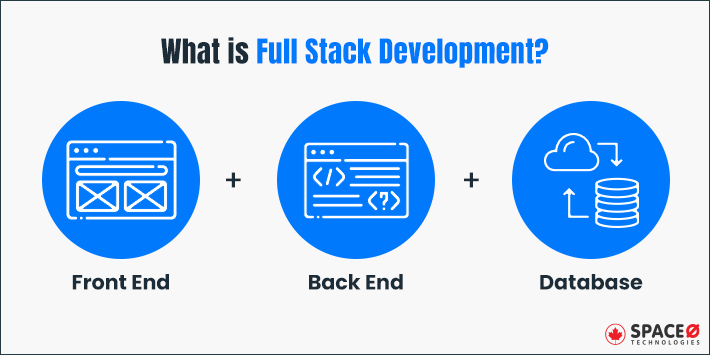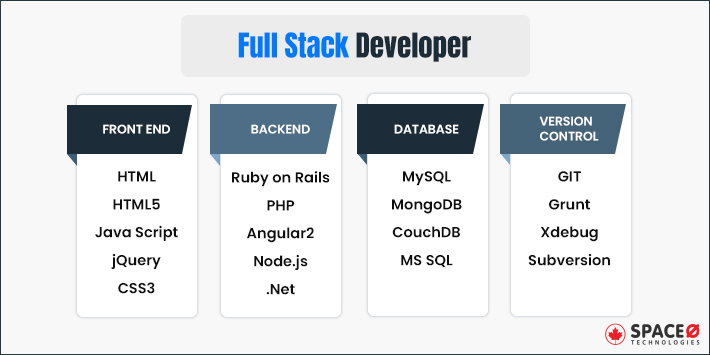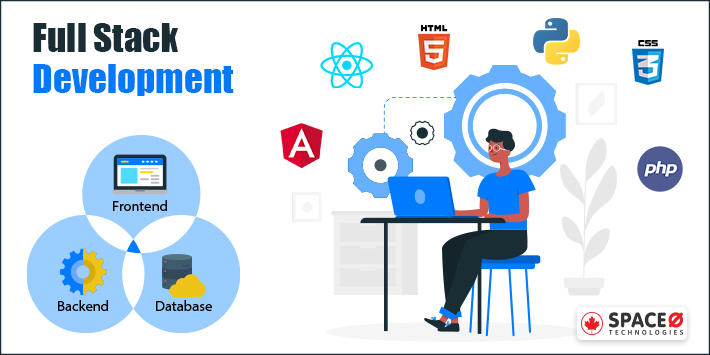- You are looking to know about full-stack development
- You are wondering if you should become a full-stack developer
- You want to know if full-stack development is a lucrative career
- You want to develop a full-stack web project
- You are wondering if you need to hire a full-stack developer or backend developer or frontend developer?
Read this blog if:
Hiring full-stack developers bring several benefits to your business, such as low costs, reduced development time, well-organized work, and high quality of development.
In fact, developers are moving towards gaining full-stack development skills as it offers more salary scope. In the StackOverflow Developer’s Survey 2021, 50.27% of respondents were identified as full-stack developers.
Check the following image of the StackOverflow survey.

Source: StackOverflow
Being a full-stack development service provider company, we often receive queries on full-stack development projects. Therefore, we have written a dedicated post to help you understand the basics of full-stack development.
Let’s start with understanding what is full-stack development and why it is so popular in the technological world today.
Table of Contents
- Get Your Project Developed With a Limited Budget
- Get Your Project Delivered on Time
- Quick Troubleshooting Throughout The Project
- Utilize the Diverse Experience of Full Stack Developers
- Get Scalable and Optimizable Code for Your Project
- Having a Developer in Your Team Who Understands In and Out
- Always Heading With Trends
- Flexibility of Full Stack Developers to Move Between Front-end and Back-end
What is Full Stack Development?
Full-stack development refers to the development of both the front end (client-side) and the back end (server-side) side.
Full-stack Development = Front-end Development + Database + Back-end Development
Check this image for reference.

- Presentation layer (deals with the user interface)
- Business logic layer (deals with data validation), and
- The Database layer
The Full-stack web development process includes:
What Does a Full Stack Developer Mean?
A full-stack developer means a developer who is skilled to work exclusively on the application’s front-end development technologies, backend web development technologies, databases, DevOps, and mobile apps. A full-stack developer deals with the technologies behind the entire application stack. Check this image for reference.

To be precise, a full-stack developer is a jack of all trades; works with JavaScript code as well as MySQL queries.
Full-stack engineers have a clear understanding of software architecture:
- Presentation layer: Deals with the front-end part of the application, i.e. user interfaces
- Business logic layer: Deals with the data validation, connectivity, server
- Database layer: Deals with the connectivity of the database from the application’s front-end
In short, a full-stack programmer knows how to work on the client and server-side and what’s happening in the app during the development process.
They can work on a web stack or native application stack depending on the client’s requirements. Thus, a full stack web developer is almost like a T-shaped developer who has knowledge of the specific language and is sound with a range of generalized concepts.
Want to Launch Your Idea Early in the Market?
We have a team of full-stack developers who understands technologies like HTML, CSS, Database, Javascript, and PHP.

What Does the Full Stack Developer Do?
The primary responsibility of a full-stack developer is to design user interactions on websites and platforms, write optimized code for mobile, and develop databases. First, let’s look at the other responsibilities of full-stack developers.
Here is a list of full stack developer’s responsibilities:
- Understand the requirements of the client and work with the development team and project managers to design a solution
- Manage databases, servers, and third-party apps
- Design and develop API
- Need to work with the entire software development team, including front-end, middleware, and back-end
- Build Proof-of-Concept (POC) to demonstrate the clients
- Ensures cross-platform optimization for mobile phones
- Ensures responsive design for all the platforms
- Works with the graphic designers for the web design features
- Understand software architecture concepts
- Test and debug the issues in the code
- From concept to implementation; they transform requirements into a finished product
- Build reusable code for future use
- Work with the creative team to design the innovative solution
- Ensures high quality of code on design and website
- Stay updated with the latest web applications and programming languages
What is Front-end Development?
Front-end development refers to creating user interface of a website or application that includes, buttons, images, text, tables and graphs.to creating user interface of a website or application that includes, buttons, images, text, tables and graphs.
A front-end development is fully focused on “client-side” development of software, web and application that code and develop the front-end components. Front-end components mean UI design elements and functions that the end-user interacts with directly.
A front-end developer is in control of everything you see on the screen and works to refine and smooth out the user interface for a better user experience. Simply, front-end web development deals with the interface and designing of an application.
What is Back-end Development?
Back-end development refers to designing architecture and writing code of an app that communicates with the database and provides results.
The back-end web development process involves server-side application logic and integration, as opposed to frontend development, which focuses on customer-facing products and programs.
Back-end developers create code for an application that connects the database with another component of an application. Apparently, back-end developers takes the charge of writing logical functionalities of application.
Furthermore, check the technologies considered in full-stack web development.
Full Stack Development Technology Stack
Below is the full stack technologies list that is used for Development.
| Front End Technology | Database | Back End Technology |
|---|---|---|
|
|
|
Difference Between Full-stack Developer and Full-Stack Engineer
The main difference between full-stack developer and full-stack engineer is full-stack developers are primarily involved in the entire project development cycle. While full-stack engineers mainly deal with application architecture to supervise the entire development. Let’s check other differences between a full-stack developer and a full-stack engineer.
| Full-stack Developer | Full-stack Engineer |
|---|---|
| A full-stack developer works on both front-end and back-end web applications and writes code, builds, monitors, and maintains the software. | A full-stack engineer is a senior-level position with full-stack web developer expertise as well as project management experience in areas such as systems administration (configuring, managing, and maintaining computer networks and systems). |
| Mostly expert in front-end and back-end database server programming languages. | Well-versed with the entire software development lifecycle (planning, requirements, design, code, test, maintenance). |
| A full-stack software developer takes the technical direction of an engineer, in most cases. | An engineer would design the architect of the solution to a problem. |
| A developer can only switch between the front end and back end. | An engineer can switch between all the various roles as and when required. |
| In demand among startups. | In demand among enterprise companies. |
But, how does it benefit from hiring full-stack developers for your business? Let us check.
What are the Benefits of Full Stack Development?
Get Your Project Developed With a Limited Budget
Get Your Project Delivered on Time
Quick Troubleshooting Throughout The Project
Utilize the Diverse Experience of Full Stack Developers
Get Scalable and Optimizable Code for Your Project
Having a Developer in Your Team Who Understands In and Out
Always Heading With Trends
Flexibility of Full Stack Developers to Move Between Front-end and Back-end
Rather than hire different professionals for the front-end and back-end separately, it is recommended to hire a full-stack developer. In addition, you can have fewer people on board as full-stack professionals easily handle the front-end and back-end of the website.
Full-stack developers’ knowledge and flexibility aid in the elimination of causes that contributes to cost overruns in the long term. This is one of the advantages of full-stack development that no business owners developing web applications can afford to ignore.
Hiring developers and managing them separately needs time, money, and effort. So, full-stack developers reduce this hassle.
Full-stack developers often work as a team within a project. This makes it possible to share job responsibilities among the participants for creating web applications. Since full-stack developers are aware of different techniques and tools, they will spend less time discussing and helping everyone in the team.
Plus, skilled full-stack web developers make the client’s website compliant with the current online safety standards and regulations. With the expertise in diverse tools and technologies, they are able to find performance bottlenecks in current web/mobile apps and quickly devise solutions.
Having a full-stack developer in the team streamlines the overall process of web development, which results in fast and timely delivery of the project.
Several types of bugs and errors can occur while developing an app or website. And this can happen at any point in web/app development. Finding the source of such errors is time-consuming for most developers. This results in an increase in costs and delays in projects.
However, the involvement of a full-stack developer improves the development procedure because such experienced full-stack developers quickly resolve the issues as they have a core understanding of the functionalities.
Since full-stack developers understand various emerging technologies, they provide better support and maintenance in application development. These programmers are more capable of troubleshooting than most developers.
Full-stack developers act as a bridge between the client and team; they can easily communicate the requirements and are skilled enough to identify the problems during the development. They even will quickly evaluate project specifications and create a viable blueprint and implementation stages.
An experienced full stack professional has in-depth knowledge about web and mobile app development. In addition, full-stack web developers are knowledgeable about the complexities of network and application development.
Their knowledge of the industry aids these developers in coming up with novel full-stack project ideas and overcoming unexpected challenges.
Since full-stack web programmers are familiar with the most recent updates and innovations, the method of managing and upgrading the Minimum Viable Product is streamlined, increasing the likelihood of favourable feedback from future consumers.
As a result, full-stack programmers are able to implement the same method in their practice, allowing customers to benefit from getting access to the latest up-to-date technology. And the clients will get the best software applications developed with the latest tech stacks.
The full-stack web developer you recruit will be accountable for the whole project, from designing front-end architecture to backend development and database management. Full-stack developers and his team takes the charge of whole project’s developing process.
As a result, when there are any problems with the delivery period or product development, the full stack developer is kept responsible. So, there are no issues or blame-shifting between any members of team. The standard of projects handled by a full-stack web developer is certainly higher than projects handled by conventional developers.
A full-stack engineer can take up the ownership of the entire project from beginning to end. If the client has asked for proof-of-concept (POC), they get involved in the middle of the project and are able to quickly build the application. Having a full-stack web developer project development adds beneficial it ensure to provide quality product.
A professional full-stack web developer always keeps him/herself up to date with new technologies. For example, these developers are familiar with progressive web applications, blockchain technologies, machine learning, and artificial intelligence (AI) development.
Since they are updated with the latest technology and frameworks, they can implement smart features to build responsive and interactive websites. Moreover, developers choose full-stack technologies depending on the trends of a web stack or native application stack.
In addition, a full-stack developer can implement the whole design structure and be able to share innovative design solutions with the UI/UX team. Apart from web development, they maintain and optimize the existing system. Using such advanced technologies we at Space-O have developed several applications, and one of them is the following. Let us address.

Custom Software Solution for Meat Processing Industry
Custom meat processing software that helps to automate the entire operation from receiving to tracking orders through a single platform. By implementing this software organization’s productivity surged by 60% and saved 70% time on generating reports.
A full-stack programmer offers a lot of flexibility because he knows both the client and server side of the application. Full-stack web developers know coding languages like Python, .NET, PHP, JavaScript, Node.js, and other latest web development frameworks. So, it becomes easy to switch between different tasks in a snap. Apart from front-end and back-end, full-stack engineers even understand DevOps and are adept at handling all three-tier architecture.
In the presence of a full-stack developer, the backend developers do not need to meet front-end developers to illustrate the problem and vice versa. A full-stack mobile developer is aware of the outcome and issues during development. So, it brings feasibility for developers to manage your project due to the advantages of full-stack web development.
Want to Build Web Applications Using Full Stack Technologies?
Hire our full-stack developers, who are adept with versatile technologies. Get your ideas validated by our full-stack development professionals.
Next, let us look at the salary range of full-stack web developers in Canada.
What is the Cost to Hire Full Stack Developers in Canada?
A full-stack developer’s salary is based on experience and technical skills.
Which are the Highest Paying Cities in Canada for Full Stack Developers?
| Cities | Salary/Year |
|---|---|
| Toronto | $ 90,292 |
| Vancouver, BC | $ 84,749 |
| Ottawa | $ 81.038 |
| Montreal | $ 80,079 |
| Calgary | $ 77,656 |
Still looking for more information on full-stack development. Check our FAQ section to find your answers.
FAQ About Full Stack Project Development
Is it a good idea to hire a full-stack developer for your project?
What are the required skills for a full-stack developer?
- HyperText Markup Language (HTML)
- Cascading Style Sheets (CSS)
- JavaScript
- Git and GitHub
- Back-end programming languages
- Web architecture and web pages
- HTTP and REST
- Lamp stack developer skills
- Database storage
- Basic design skills for mobile and web pages
- Soft skill-set and NPM
- Web stack and development languages
What is the difference between Mean Stack and Full-Stack?
Yes. Hiring a full-stack web developer from a reputable firm is the perfect option for your business because the firm would have seasoned developers with a solid product pipeline that will fulfill the project’s requirements. Furthermore, the company’s engineers would be skilled and knowledgeable about cutting-edge technology that will be beneficial to your business.
To become a full-stack developer, you need to have knowledge of the following technologies.
The main difference between Mean stack and full-stack development is that Full-stack involves working with a set of software and programming languages like HTML, CSS, and Javascript that a software developer learns in order to operate on both the front-end and back-end of a website. While Mean stack is a framework that contains MongoDB, Express.js, AngularJS, and NodeJS.
Develop Your Custom Full-Stack Solution
Broad and detailed knowledge of various aspects of development – a full-stack developer often gives you an advantage over an app developer. They do both the client and server sides of software development, and it’s simple to delegate responsibility or version control of the project to them.
So are you all set to initiate your app project with full-stack web developers? Contact us today. Being a full-stack development company in Toronto, we have delivered more than 100 projects successfully. In case of any queries, fill out our contact us form and get a FREE consultation with our professional developers.
 By
By 



